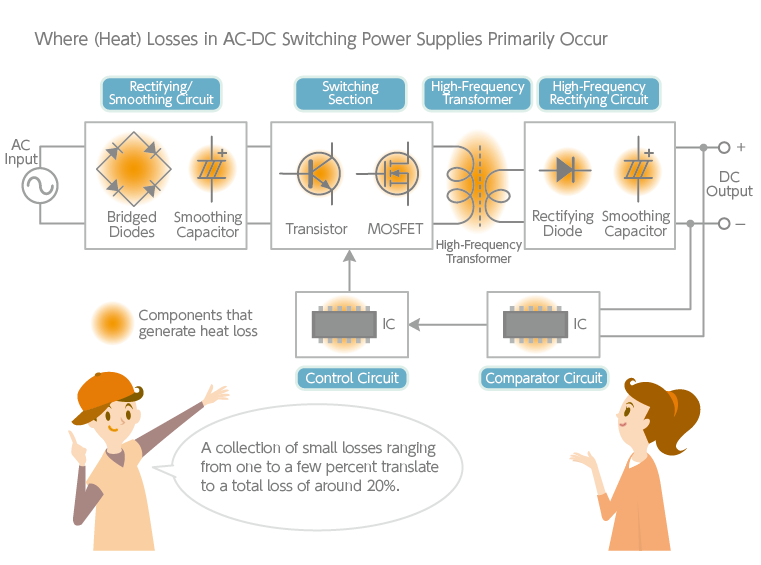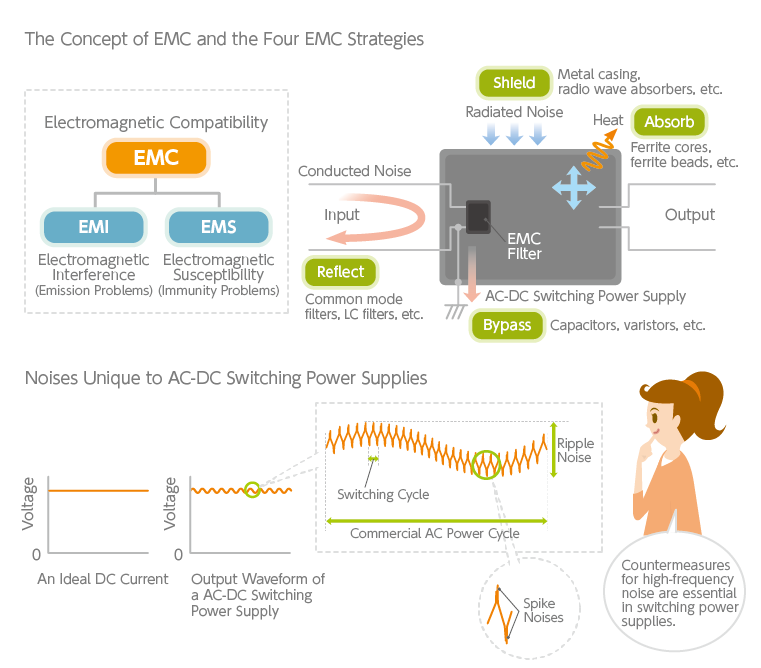The World of Power Electronics
Part 5: Distributed Power Supply Systems and Power Modules

Despite the strong calls for energy conservation, IT-related power consumption has been rising rapidly in recent years. In addition to the power consumption of the devices themselves, the power needed for heat removal and cooling is also growing. At this rate, it is predicted that IT alone will account for about a quarter of Japan’s total power consumption by 2025. The power supply is the heart of electronic devices. Even a 1% improvement in efficiency can have a significant energy-saving effect.
Will household electricity use DC power distribution in the future?
Because most electronic equipment is powered by direct current (DC), alternating current (AC) power taken from the wall outlet is converted to DC and fed into the circuit. As we have explained previously, this AC-DC conversion is mainly done by highly efficient switching systems (e.g., AC-DC switching power supplies). However, there is still a conversion loss of about 10%, and part of the electrical energy is lost as heat. Although AC power distribution is a mature technology that has made vast progress since the 19th century, it is not necessarily the optimal power supply system for today’s needs.
In order to save energy and reduce CO2 emissions, recommendations are being made to replace the current AC with DC for homes and offices using DC power distribution. DC power distribution is highly compatible with power generation systems that utilize natural energy. If the use of solar, wind and small-scale hydroelectric power becomes widespread in homes, for instance, the power generated can be stored in batteries for practical use. Since batteries supply direct current, they are compatible with direct current power distribution, making them convenient for use. Another advantage of DC distribution is that noise problems associated with AC-DC conversion can be avoided.
However, even with DC power distribution, power converters are still indispensable for electronic devices. The DC voltage required to drive electronic circuits varies, and DC-DC converters provide this needed voltage conversion. Improving the conversion efficiency of DC-DC converters has become a prime issue in power electronics.
Recent advances in semiconductor technology have also brought about significant changes in power supply systems as a whole. For example, the standard DC output of DC-DC converters installed in electronics, such as PCs, used to be 12V for analog circuits and 5V or 3.3V for digital circuits. In recent years, however, there has been a trend towards lower voltages, such as 2V, 1.2V, or even less than 1V. This trend is due to the increasing miniaturization and integration of semiconductors—in response to the need for faster processing speed and more multi-functionality—which in turn has led to lower voltages and larger currents in ICs.
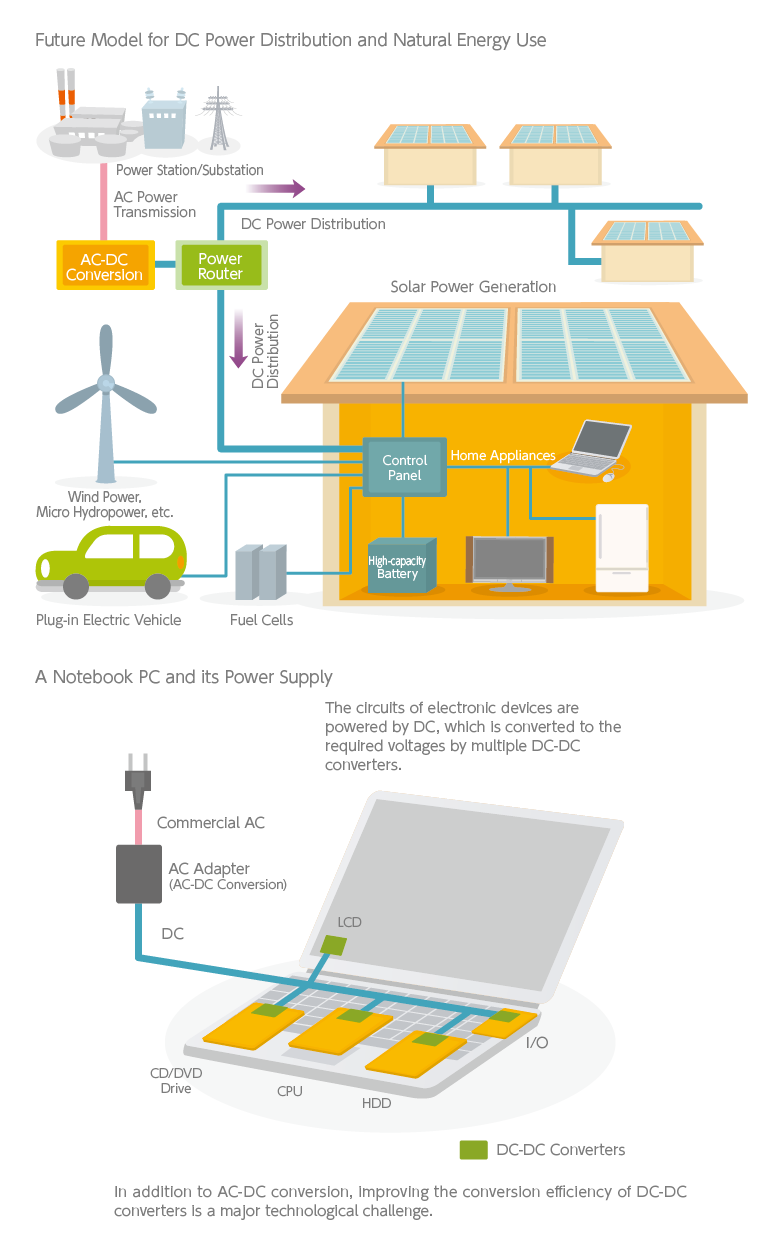
Shifting to distributed power supply systems to accomodate lower voltages and larger currents in IC circuits
DC-DC converters can be broadly divided into two types: isolated and non-isolated. In order to prevent electric shock, the input and output sides of the power supply must be electrically isolated at some point. The primary and secondary windings of a transformer are electrically isolated. Isolated DC-DC converters use transformers, while non-isolated DC-DC converters are small DC-DC converters that do not use transformers (the output voltage of the non-isolated type is low, so there is no risk of electric shock).
It is not technically challenging to create a single DC-DC converter with multiple outputs that supply all the necessary DC voltages. However, this is not the best system in terms of efficiency or cost. Hence, an idea was proposed to use a main DC-DC converter (isolated type) to first step down to an intermediate voltage, then use multiple small DC-DC converters (non-isolated type) to branch off and supply the various DC voltages needed. This system is called a distributed power supply.
For example, the power supply system for IT equipment, such as communication devices and PCs, consists of an AC-DC switching power supply that converts commercial AC into DC, and multiple DC-DC converters that convert the DC voltage. In the past, AC-DC switching power supplies were used to convert the voltage to 48V DC for communication devices and 12V DC for PCs—which was then used as the bus voltage to obtain the required DC voltages using DC-DC converters. However, this system is no longer able to handle the low voltages and large currents of ICs. If the difference between the input and output voltages is too large, efficiency is reduced. Furthermore, as frequencies are increased to speed up ICs, the effects of the wiring (resistance and inductance components) between the DC-DC converter and IC can no longer be ignored. As a result, the DC-DC converter must be placed as close as possible to the IC (called Point of Load, or POL). However, this isn’t easy to achieve with DC-DC converters fitted with heat sinks (heat dissipation plates).
Power supply design is a battle against heat. Increasing efficiency means reducing heat loss, and when heat loss is reduced, cooling fans and heat sinks become unnecessary. Also, if they are made small enough to be onboard types, they can be mounted anywhere on a printed circuit board. These are reasons why distributed power supply systems—those that first obtain intermediate voltages from isolated DC-DC converters and then divert these voltages to multiple non-isolated, compact onboard DC-DC converters—have been adopted.
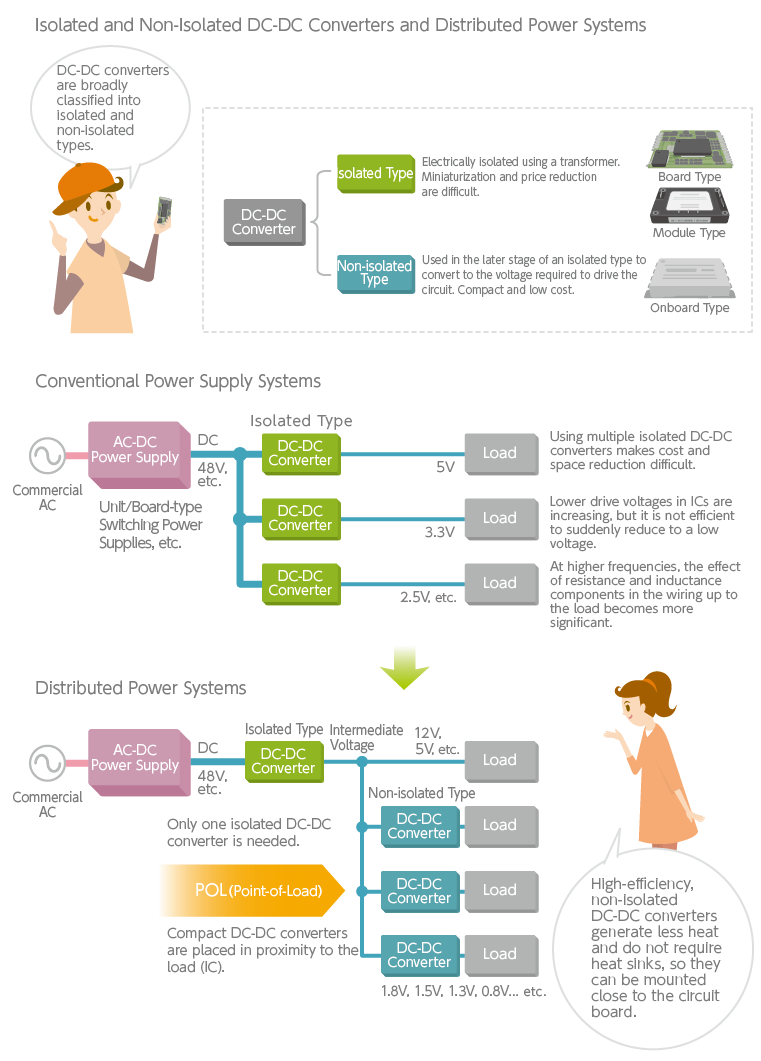
AC-DC power modules for easy and flexible distributed power supply systems
Power supplies are often made up of easy-to-handle, compact modules. These are called “power modules,” which combine power ICs and peripheral control circuits into a single package. Most power modules are commercially available in a standard size called the “brick”—the rectangular shape of the case resembles a brick. A full brick is slightly larger than a cigarette pack (116.8 mm length by 61 mm width by 12.7 mm height for TDK-Lambda products). Its 1/2, 1/4, 1/8, and 1/16 sizes are called half-brick, quarter-brick, eighth-brick, and sixteenth-brick.
Some AC-DC power modules incorporate an AC-DC rectifier section in the first stage of the DC-DC converter. The PFE series is Japan’s first AC-DC power module lineup that combines a high-performance AC-DC front-end and DC-DC converter into a single full-brick size module (some are in proprietary sizes) with PFHC functionality (also known as PFC, for harmonic current suppression and power factor correction). Commercial AC is not a perfect sine wave but is distorted by harmonics (waves that are integer multiples of the fundamental frequency). This distortion causes the power factor to drop and lowers conversion efficiency. The PFHC function suppresses this harmonic current and improves the power factor.
The PFE series, despite its high power, is a type that does not require a cooling fan due to conduction cooling, which dramatically increases the design flexibility of the power supply. It can be used as a stand-alone intermediate bus converter or combined with multiple non-isolated DC-DC converters to build a variety of distributed power supply systems. It is an ideal, compact, high-efficiency power supply for industrial, communication, and other equipment.
A myriad of electronic devices supports modern society. Conversion losses always accompany energy conversion, but an improvement as small as 1% in the conversion efficiency of a power supply can have tremendous energy-saving effects worldwide and help reduce CO2 in the atmosphere. At the forefront of power electronics, the reduction of all kinds of losses is being pursued relentlessly—leveraging materials technologies, circuit technologies, and simulation-based heat dissipation designs.
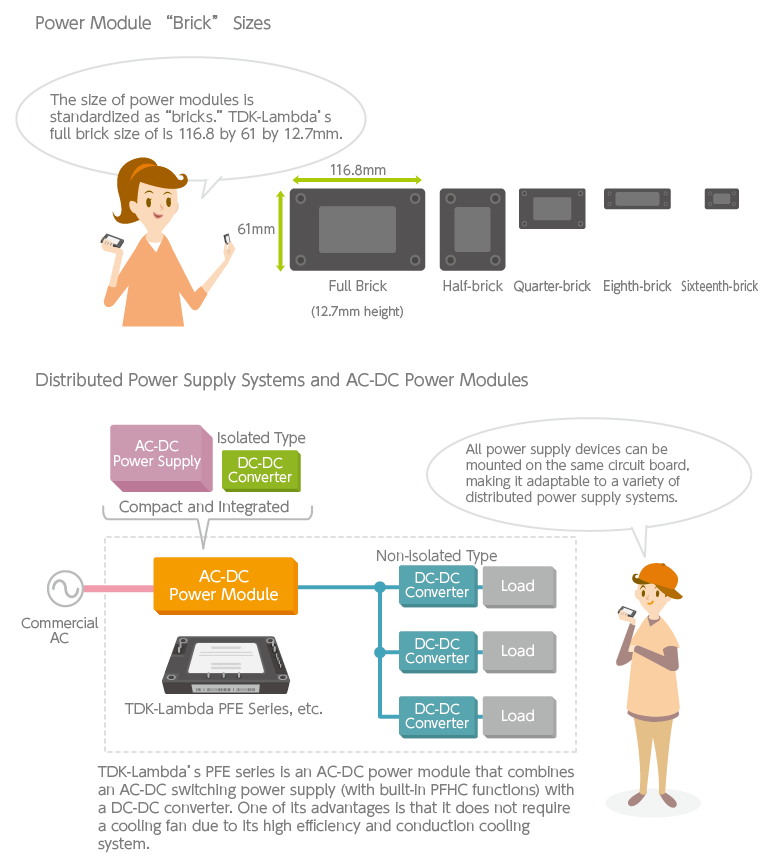
TDK is a comprehensive electronic components manufacturer leading the world in magnetic technology



